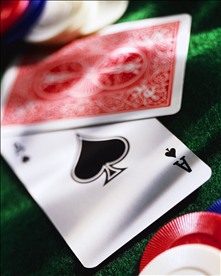Inducing A Bluff In Poker
 A good poker player will continue to add pieces to his or her game continuously. When you first start out, you play “by the book” so to speak, and over time develop skills which add to your game and you begin to develop your own style of poker. One of the tools you can add that will increase your profitability at the poker table is the ability to induce a bluff from your opponent. This is a concept that can be applied to nearly any form of poker.
A good poker player will continue to add pieces to his or her game continuously. When you first start out, you play “by the book” so to speak, and over time develop skills which add to your game and you begin to develop your own style of poker. One of the tools you can add that will increase your profitability at the poker table is the ability to induce a bluff from your opponent. This is a concept that can be applied to nearly any form of poker.
An example of a time when you would want to induce a bluff is on the river when you suspect your opponent has been on a draw and missed on the river. You are pretty sure that you have the best hand and you want to get the most value from it. However, if you bet, your opponent will fold because they have a weak hand. So the only chance you have of making any money on the river is to check and hope that they fire a bet at the pot.
When someone is on a bluff, they are going to hope no one gets a read on them, and if they do, will usually lay down there hand, however if you can induce a bluff, you will often get a lot of money thrown your way, as the bluffer does not know they are being trapped. There are a few different ways you can go about this.
One great way of getting someone to bluff at you is to check or make a smooth call when you have a very strong hand. Most players will see your check as a sign of having a weak hand and a loose aggressive player is going to bet in hopes of everyone folding and picking up a small pot. The only issue with this is that if you check, you are allowing them to get a free card, which gives them the opportunity to make their hand on the flop. If you are doing this correctly and have a very big starting hand, you run a much lesser risk of this happening.
Another way to get a player to bluff at you is by making a small bet. The goal of this is to have them perceive your small bet as having a weak hand and this will cause them to re-raise you in an attempt to get you to fold. This strategy is best when you are already in a heads up, or heads up plus one to act type of situation, such as being in the small blind, or even on the button, attempting to make the small raise look like a steal. There are many small mind games you can play here as well, by calling the re-raise and checking in the dark. This can obviously be risky, but will really make your opponent think, and should only be done with a top premium hand.
This is not a piece of your game that you will install and it will be perfect, it takes repetitive practice and observation. You really want to be able to have a very good read on your opponent’s style and range when executing this play. You also want to be aware of how you are being perceived at your table, because remember, inducing a bluff from someone is all about making them think one way when you are in fact playing the exact opposite. Be aware of what you have done in other situations, and the time you are taking to make your decision, as it seems everyone uses that to get a read on a player. Being able to induce a bluff at the table may be just what you need to take your game to the next level.

